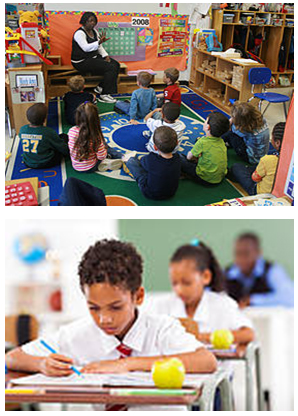Global Foundation to Upgrade Underserved Primary and Secondary Schools
Educate to Uplift, Elevate and Create Self-relianceUS AND CANADA
The State of Underserved Primary and Secondary Schools
The underserved communities, in our surrounding cities and towns with opulence, are the most misunderstood and least emphasized as needs worthy. The poor, to many of us, do not contribute to the economy, are non productive, lazy and a" drag" on society and therefore not worthy of policy makers' attention. But, this only contributes to lack of how to find solutions to address issues affecting the schools in the poor underserved communities.
 It is a well known fact that no other sector of our economy reflects the fractured nature of civil society in the United States more than public education. Despite a Supreme Court decision calling for schools to be racially integrated, public schools across the United States remain largely segregated with respect to the race and class make-up of their student populations (Orfield and Eaton 1996). Public schools are not only segregated, but in most American cities, poor children have been consigned to schools that show very little evidence of serving their educational needs. On every known measure of academic performance, the vast majority of students attending urban public schools in the United States (especially those who are African American and Latino), are deficient with respect to basic literacy and math skills (Miller 1995; James, Jurich and Estes 2001).
It is a well known fact that no other sector of our economy reflects the fractured nature of civil society in the United States more than public education. Despite a Supreme Court decision calling for schools to be racially integrated, public schools across the United States remain largely segregated with respect to the race and class make-up of their student populations (Orfield and Eaton 1996). Public schools are not only segregated, but in most American cities, poor children have been consigned to schools that show very little evidence of serving their educational needs. On every known measure of academic performance, the vast majority of students attending urban public schools in the United States (especially those who are African American and Latino), are deficient with respect to basic literacy and math skills (Miller 1995; James, Jurich and Estes 2001).
Desegregated schools are tragic failures in some cases, because policy makers failed again to understand the root cause of the failures of minority children in the public school system and to adequately perceive the outcome. There is no evidence to indicate that minority students are not as smart as children from the upper class and white community. If minority youths are given the choice between getting a good education and remaining in poverty, they would choose the education. So then, what is the problem? Right wing pundits and liberal commentators put the blame on the parents, the teachers and the school board just to name a few. Let's take a school with proven success and duplicate that model in the underserved communities. The school should have identical structures, and resources.
Let's hire the best and brightest female and male teachers reflecting the composition of the school and assign them a mission "to teach." Would the outcome be different? What do we have to lose? Let's monitor the school for results over a 3 year period and make minor adjustments as needed and draw a conclusion for further implementation.

Currently, responsibility for monitoring educational quality is delegated to educational leaders in school districts and elected school boards in keeping with the long-standing practice of allowing local communities to manage and operate public schools. (Blasi 2001)
There is a vast body of research and evidence that shows such an approach does not work. In most cases, poor communities lack the resources necessary to monitor the quality of education provided to students. Concentrated poverty and racial isolation limit the ability of parents to exert control over the schools that serve their children, and educational leaders in such communities often lack the resources to take on the task themselves. For a variety of reasons, conditions external to schools such as poverty, crime, housing affordability and health care access, exert considerable influence over conditions within schools (Coleman, et.al. 1966; Noguera 1996).
Unless the state intervenes decisively to support schools in low-income communities, it is unlikely that such schools will ever improve,
References
- http://www.globalpovertyproject.com/infobank/women
- http://educationnext.org/privateschoolsforthepoor/
- http://www.data-first.org/data/what-is-the-poverty-level-of-our-schools/
- http://steinhardt.nyu.edu/metrocenter.olde/resources/PDF/Racial%20Isolation.pdf
- http://en.wikipedia.org/wiki/Education_in_the_United_States
- http://en.wikipedia.org/wiki/Education_in_the_United_States
- http://www.nagc.org/uploadedFiles/News_Room/NAGC_Advocacy_in_the_News/NAGC%20MESSAGES%20(for%20website).pdf
- http://www.urban.org/UploadedPDF/overlooked.pdf

